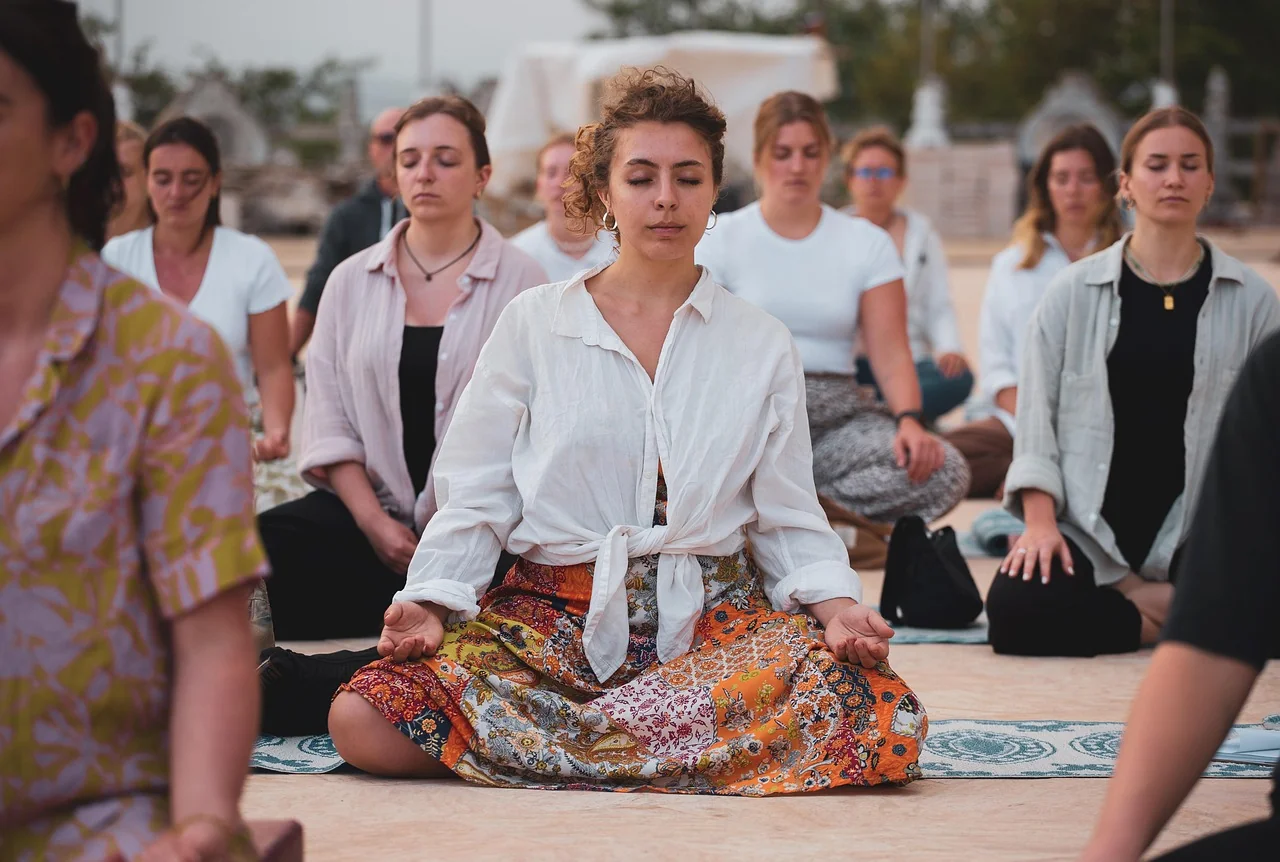That dreaded 2:30 PM feeling is real. Your energy plummets, focus scatters, and the temptation of another coffee or a sugary snack hits hard. This "afternoon slump" isn't just in your head—it's a biological dip in your circadian rhythm. But what if you could navigate this energy crash and emerge more focused and calm? The most powerful tool you can reach for is an afternoon meditation guided practice. This isn't about adding another task to your day; it's a strategic reset that replaces fatigue with renewed clarity. In this ultimate guide, you’ll discover exactly how a brief, guided session can recharge your mental batteries, dissolve built-up stress, and propel you through the rest of your day with intention and ease. We're covering the science-backed benefits, how to create your perfect meditation space (even at a busy office), and a step-by-step plan to transform your afternoons.
Why Your Afternoon is the Perfect Time for a Guided Meditation
Your body’s internal clock, or circadian rhythm, naturally dips in alertness between 2 PM and 4 PM. This is a well-documented phenomenon, often unrelated to how much sleep you got the night before. It’s a primal, post-lull designed for rest. Instead of fighting this biology with stimulants, an afternoon meditation guided session works with it, offering a purposeful pause that restores your system.
This time of day is uniquely positioned for a mental reset. The morning’s stresses and demands have already accumulated, and the evening’s responsibilities are looming. A guided meditation acts as a circuit breaker. It stops the momentum of stress and fatigue in its tracks, preventing it from spilling over into your personal life. It creates a clear demarcation between the first half of your day and the second, allowing you to finish strong.
Choosing a guided meditation is the key to success during this low-energy window. When your willpower is depleted, the mental effort required for silent meditation can feel like too much. A guide does the heavy lifting for you. Their voice provides an anchor for your attention, pulling you back when your mind wanders to your inbox or your to-do list. This structure makes the practice accessible, especially for beginners, and ensures you get the most out of your limited time.
The Transformative Benefits of an Afternoon Meditation Guided Practice
Integrating just 10 to 15 minutes of guided meditation into your afternoon can yield profound and immediate benefits. This practice is more than a quick fix; it’s a sustainable habit that compounds over time, enhancing your well-being, productivity, and overall quality of life.
Recharging Your Mental Energy
That afternoon fog isn't just fatigue; it's often cognitive overload. Your brain has been processing information and making decisions all morning. A guided meditation practice provides a much-needed system reboot. By focusing on the breath and the guide’s voice, you allow the default mode network of your brain—the part associated with mind-wandering and self-referential thought—to quiet down. This short break reduces mental clutter, clearing the fog and making space for renewed creativity and sharpness.
Releasing Built-Up Stress and Anxiety
From a difficult meeting to a looming deadline, the morning can stockpile low-grade stress. An afternoon session is the perfect opportunity to consciously release this tension before it becomes chronic. Guided meditations often incorporate body scans and breathwork that activate the parasympathetic nervous system—your body’s "rest and digest" mode. This directly counteracts the stress response, lowering your heart rate and blood pressure, and melting away the physical manifestations of anxiety. If you find stress is a common theme in your day, you may want to explore the best guided meditation for anxiety for more targeted support.
Enhancing Focus and Productivity for the Rest of Your Day
A scattered mind is an unproductive mind. Meditation is like a workout for your attention muscle. By repeatedly guiding your focus back to a single point (like your breath or a mantra), you strengthen your ability to concentrate. Walking back to your desk after a session, you’ll find it easier to prioritize tasks, ignore distractions, and engage in deep work. You’re not just working harder; you’re working smarter with the time you have left.
Cultivating Mindful Awareness and Patience
As energy wanes, patience often wears thin. You might find yourself more irritable with colleagues, family, or the slow-moving line for coffee. An afternoon meditation guided session brings you back into the present moment, fostering a state of non-reactive awareness. You create a small gap between a stimulus (a frustrating email) and your response. In that gap, you can choose a calmer, more compassionate reaction, improving your interactions and conserving emotional energy. This practice of compassion can be deepened with a guided meditation for love to cultivate kindness for yourself and others.
Improving Work-Life Balance
For many, the end of the workday is a blurry transition. You might physically leave the office but mentally carry work home with you. A deliberate afternoon meditation creates a powerful ritual that signals the end of the "work" chapter and the beginning of the "personal" chapter. It allows you to process the day’s events, let go of work-related thoughts, and arrive home more fully present for your loved ones and yourself.
How to Create Your Perfect Afternoon Meditation Space
Your environment plays a crucial role in the success of your practice. The goal isn’t to find a soundproof monastery, but to create a small, consistent sanctuary that signals to your brain it’s time to unwind. This can be adapted for both home and office settings.
The Ideal Home Setting Find a quiet corner in your home that feels separate from your main areas of activity. It doesn’t need to be a dedicated room—a spot in your bedroom or a quiet nook is perfect.
- Comfort is Key: Sit on a meditation cushion, a firm pillow, or a chair. Your spine should be straight but not rigid, and your body should feel supported.
- Set the Mood: You can dim the lights or draw the curtains. Some people find it helpful to light a candle or diffuse a calming essential oil like lavender or sandalwood.
- Minimize Tech: Ensure your phone is on silent or "Do Not Disturb" mode. If you’re using it to play your guided meditation, turn on airplane mode to avoid notifications.
The Office Oasis Meditating at work is not only possible; it’s incredibly effective for managing workplace stress. You don’t need much space or time.
- Your Car: A parked car in the lot is a private, quiet space for a 10-minute session.
- An Empty Room: Book a small conference room or find a quiet breakout space for a few minutes.
- At Your Desk: This is the most accessible option. Simply sit back in your chair, plant your feet firmly on the floor, and put on your headphones. A small sign that says "Heads Down Time" or "Recharging until 2:15" can manage expectations and prevent interruptions.
Essential Props for Success You don’t need expensive gear, but a few items can enhance your experience.
- Headphones: Noise-canceling headphones are a game-changer, especially in a noisy environment. They help you fully immerse in the guide’s voice and block out distractions.
- A Meditation App or Playlist: Have your favorite meditation app or a saved playlist of guided sessions ready to go. This eliminates fumbling and helps you start immediately.
- A Shawl or Blanket: Your body temperature can drop when you sit still. Having a light blanket nearby keeps you comfortable and undisturbed.
A Step-by-Step Guide to Your Afternoon Meditation Session
Follow this step-by-step guide for your afternoon meditation guided practice. Consistency is more important than duration, so even a 5-minute session is beneficial if that’s all you have.
Step 1: The Transition (1-2 Minutes) Don’t jump directly from your work into meditation. Create a brief transition ritual. Close your eyes, take three deep, intentional breaths, and gently set an intention for your practice. This could be as simple as, "I am doing this to reset and recharge." Acknowledge any thoughts about work, and mentally set them aside with the promise that you can return to them later.
Step 2: Getting Comfortable (1 Minute) Find your seated position. If you’re on a chair, ensure your feet are flat on the floor and your back is supported away from the chair back. If you’re on a cushion, cross your legs comfortably and ensure your hips are slightly elevated above your knees. Rest your hands on your knees or in your lap. Gently close your eyes.
Step 3: The Guided Meditation (10-15 Minutes) Now, start your chosen guided meditation. As the guide begins to speak, surrender to the process.
- Follow the Anchor: The guide will give you a primary anchor for your attention—usually the breath, a body scan, or a visualization. Do your best to follow their instructions.
- Embrace the Wandering Mind: Your mind will wander. This is not a sign of failure; it is the entire point of the practice. The moment you notice your mind has drifted to a work problem or your shopping list, gently and without judgment, guide it back to the sound of the guide’s voice. This act of noticing and returning is the repetition that builds your mindfulness muscle.
Step 4: The Gentle Return (2-3 Minutes) As the meditation comes to a close, the guide will likely bring your awareness back to the room. Don’t rush to open your eyes or jump up. Take a few moments to sit in silence. Notice how your body feels. Notice the quality of your mind. Is it quieter? Slower? More spacious? Wiggle your fingers and toes, and when you feel ready, slowly open your eyes.
Step 5: Integrating the Calm (1 Minute) Before you dive back into your day, take one more minute. Slowly stretch your arms overhead. Perhaps take a sip of water. Set a final, gentle intention for the rest of your afternoon, such as "I will move with focus and ease." This integration phase helps you carry the calm from your practice into your next activity.
Finding the Right Guided Meditation for You
With countless resources available, finding a guide and style that resonates with you is essential for building a lasting habit.
- Explore Different Apps: Popular apps like Calm, Headspace, and Insight Timer offer vast libraries of guided meditations specifically for an afternoon energy boost, focus, or stress. Many have free guided meditation content to get you started.
- Search on YouTube: A simple search for "afternoon meditation guided" will yield hundreds of results. Look for guides with a voice and pacing you find soothing.
- Sample Different Styles: Try a body scan to release physical tension, a loving-kindness meditation to boost compassion, or a simple breath-focused session for mental clarity. Your needs may change from day to day.
A Sample Afternoon Guided Meditation Script to Get You Started
If you prefer to start right now without an app, you can read this script slowly to yourself, record it in your own voice, or have it handy as a guide. For more structured practices, you can adapt a guided meditation script for relaxation to fit your afternoon needs.
(Find a comfortable seated position. Gently close your eyes.)
"Welcome to this afternoon reset. Begin by bringing your awareness into your body. Feel the points of contact—your feet on the floor, your body on the chair or cushion. Notice the air on your skin.
Now, take three deep, full breaths. Inhaling a sense of calm, exhaling any immediate tension you're holding. With each exhale, imagine letting go of the morning's busyness.
Gently allow your breath to return to its natural rhythm. Bring your attention to the physical sensation of breathing. Feel the cool air entering your nostrils, and the slightly warmer air leaving. Notice the rise and fall of your chest or belly. There's no need to control it; just observe.
Your mind will wander. That’s perfectly okay. When you notice it has drifted away, perhaps to a thought or a sound, simply acknowledge it with a gentle, ‘Ah, thinking,’ and guide your attention back to the feeling of your next inhale and your next exhale.
Now, let’s do a quick body scan to release physical stagnation. Bring your awareness to the top of your head. On your next inhale, imagine drawing a wave of relaxation down through your body. Feel it softening your forehead, relaxing your jaw, and dropping your shoulders. Let it flow down your arms to your fingertips, down your torso, and all the way to your toes. With each exhale, release any remaining heaviness or fatigue.
Now, resting your awareness back on your breath. Inhaling calm. Exhaling fatigue. Sitting in this quiet, restorative space for the next few moments, simply breathing.
Slowly, begin to deepen your breath once more. Gently wiggle your fingers and toes, bringing gentle movement back into the body. When you feel ready, slowly and gently open your eyes.
Take a moment to notice how you feel before you move back into your day, carrying this sense of calm focus with you."
Overcoming Common Afternoon Meditation Challenges
It’s normal to encounter obstacles, especially when starting. Here’s how to navigate the most common ones.
- "I’m too busy." This is the most common objection. The truth is, you are too busy not to meditate. A 10-minute investment that boosts your focus and efficiency for the next two hours is a net time gain. Schedule it in your calendar like any other important meeting.
- "I keep falling asleep." This is very common during the afternoon slump. If you find yourself nodding off, try meditating with your eyes slightly open, with a soft gaze on the floor. You can also sit upright in a chair without leaning back, or even try a walking meditation instead.
- "My mind won’t be quiet." Releasing this expectation is the first step to a successful practice. The goal is not to stop thoughts, but to change your relationship with them. The act of noticing they are there and gently returning to your anchor is the practice. Every time you do it, you are succeeding.
Making Your Afternoon Meditation a Sustainable Habit
Consistency transforms a one-off experiment into a life-changing tool.
- Start Small: Commit to just 5 minutes, 3 times a week. A small, achievable goal builds confidence and momentum.
- Pair it with an Existing Habit: This is called habit stacking. Meditate right after you finish your lunch, or immediately after you return to your desk from a break. The existing habit acts as a trigger for the new one.
- Be Kind to Yourself: Some days your meditation will feel deep and peaceful; other days it will feel like a struggle. Both are equally valuable. Approach your practice with a sense of curiosity and compassion, never judgment.
The afternoon slump is an inevitability, but how you respond to it is a choice. Reaching for an afternoon meditation guided session is a powerful act of self-care that directly fuels your productivity, peace, and presence. It’s a practical, accessible tool that turns a period of struggle into an opportunity for renewal. By carving out this small pocket of time, you invest not just in the rest of your day, but in a calmer, more focused, and more resilient you.
In conclusion, integrating a guided afternoon meditation into your daily routine is a powerful, accessible strategy for reclaiming your day. This practice serves as a deliberate pause, effectively combating the midday slump by refreshing your mind, releasing accumulated stress, and restoring your focus. The key takeaways are clear: even a brief, ten to fifteen-minute session can significantly enhance mental clarity, emotional equilibrium, and overall productivity for the remainder of your day. By establishing a consistent habit and exploring different styles of guidance, you can tailor this practice to your unique needs, transforming a potential period of fatigue into one of renewal. The main message remains that this simple ritual is not a luxury but a practical tool for sustainable well-being. We encourage you to select one of the many available resources and commit to your first session this week. Begin this journey today and discover how a few quiet moments can profoundly reshape your afternoons, leading to a more centered, peaceful, and energized life.


